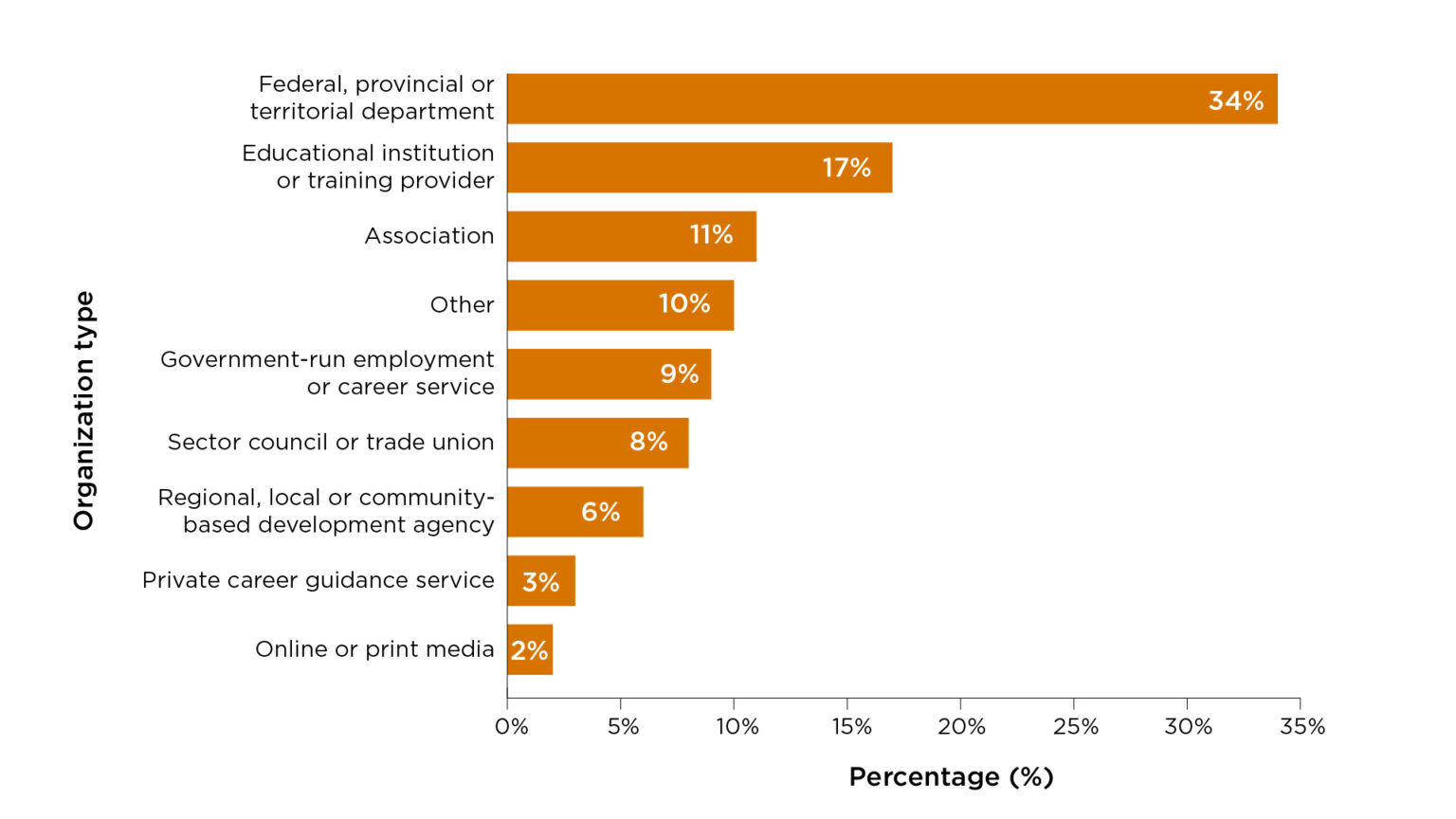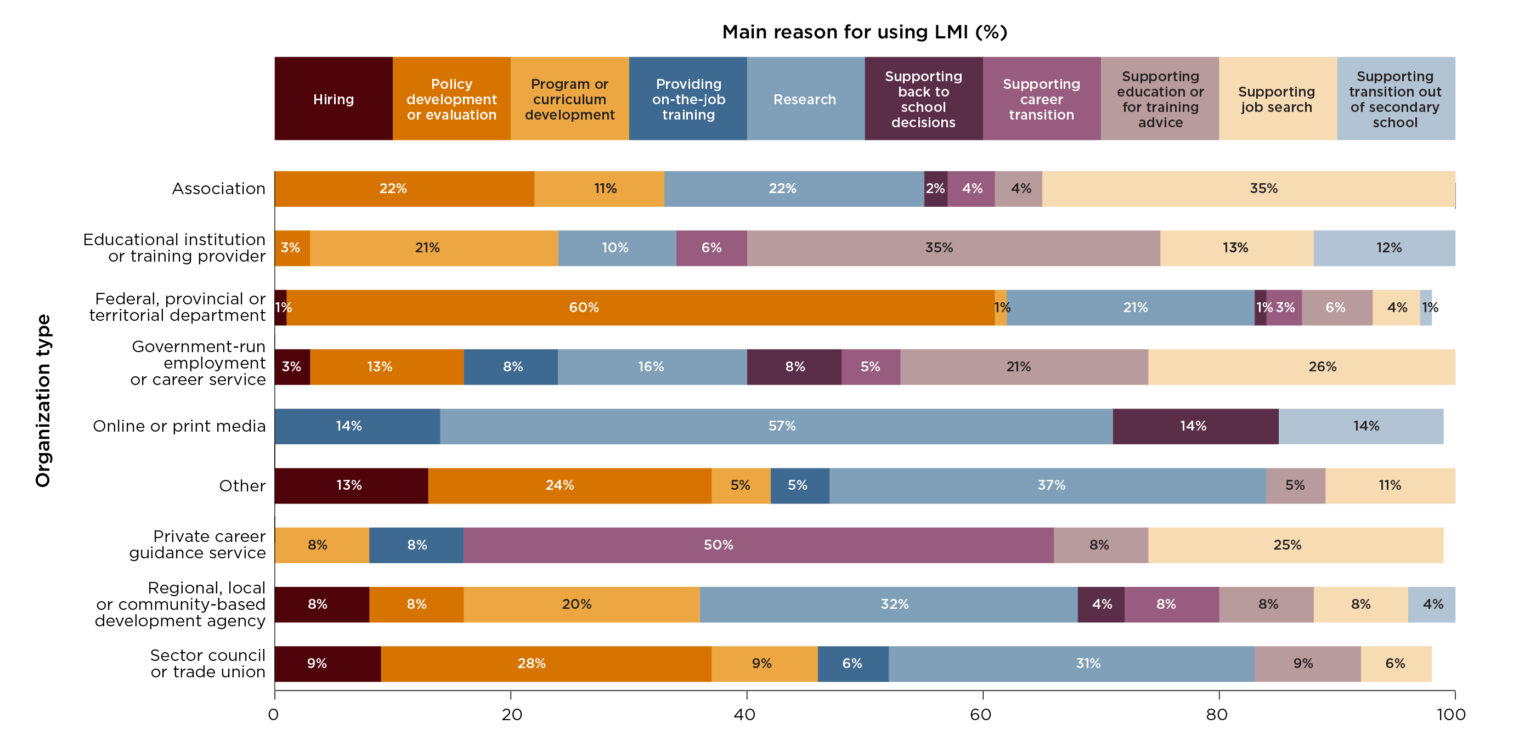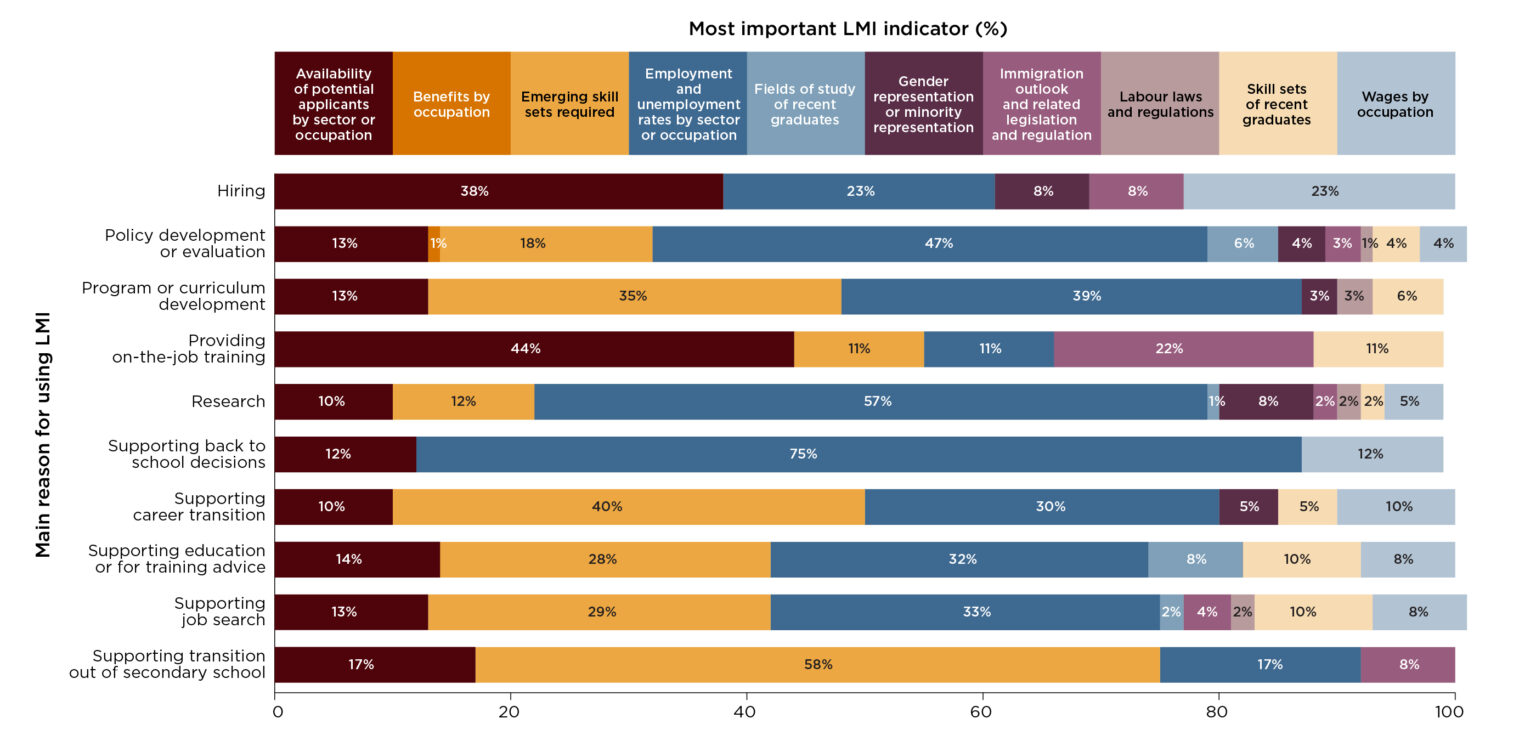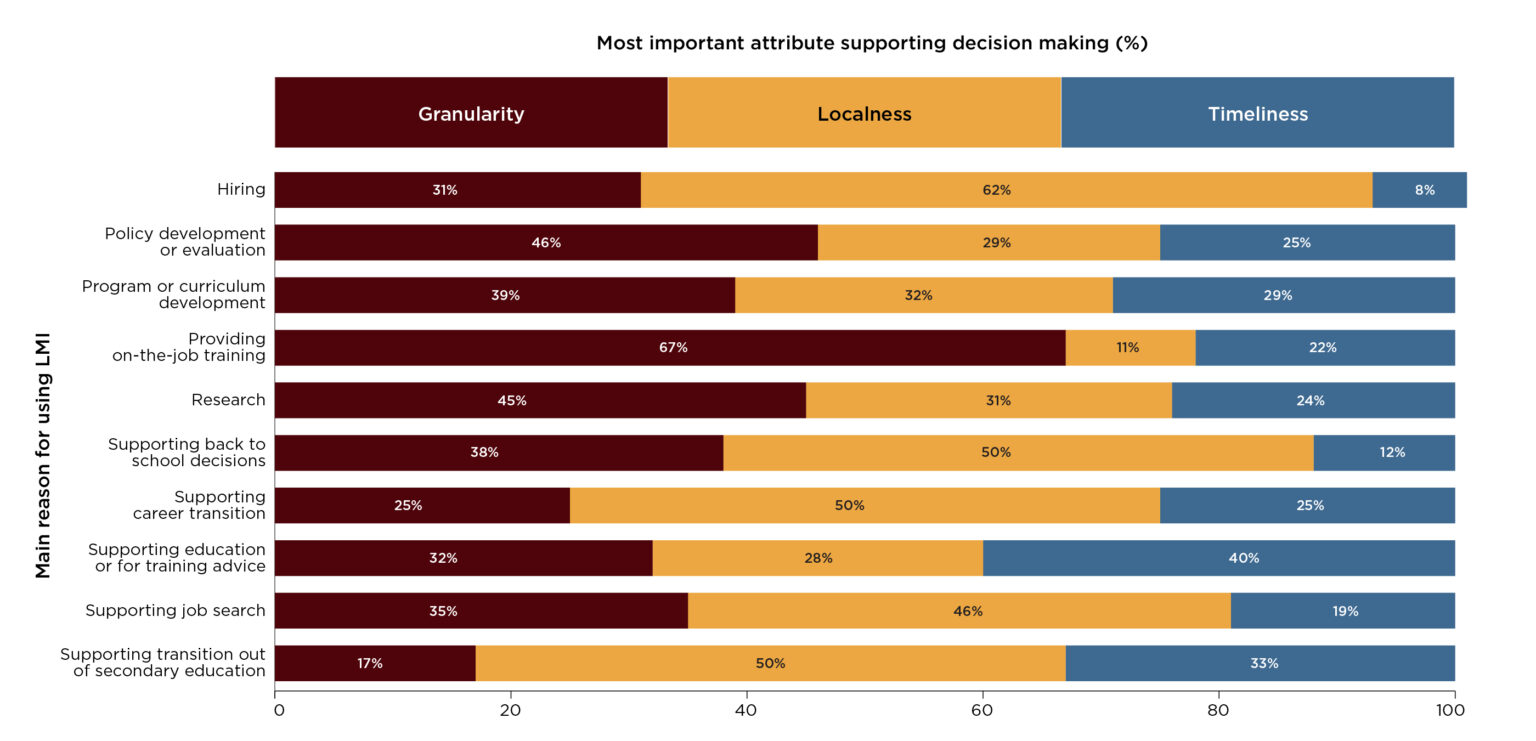May 2023
Perceptions of LMI: Feedback from the Canadian ecosystem
A feedback-gathering exercise to explore information needs in Canada’s LMI ecosystem


Listen to this report as an audio recording
KEY FINDINGS
The Labour Market Information Council (LMIC), in partnership with Statistics Canada, conducted a feedback-gathering exercise in 2021 to better understand the existing needs and uses for information about Canada’s labour market. This exercise provided some key insights about labour market information and how it is used.
All the individuals consulted in this feedback-gathering exercise reported using labour market information to support decision-making.
The reasons that organizations use labour market information varies, but the type of indicators they are looking for tend to be similar.
Labour market information needs to be sufficiently tailored to meet individual needs.
Individuals have very different needs when it comes to the localness, granularity (level of detail) and timeliness of labour market information. The attributes most important to an individual depend on how they use the information.
Statistics Canada is viewed as an important and popular source of labour market information.
Table of contents
Introduction
The world of work is changing. Mega-trends, like technological advancement and demographic shifts as well as the COVID-19 pandemic, have led to persistent labour market disruptions.
This has also increased uncertainty: from large-scale job losses and labour and skills shortages to declining job quality and questions about the structure of work, these changes have made it even more important that all people in Canada have access to timely, local and reliable labour market information (LMI) so that they can make informed career decisions.
LMIC and Statistics Canada are dedicated to ensuring all people in Canada have access to high-quality labour market information. To this end, we collaborated to conduct a feedback-gathering exercise to shed light on the existing gaps in Canada’s LMI ecosystem. In particular, the aim was to better understand gaps that were recently highlighted by the COVID-19 pandemic, such as:
Our aim was to get a sense of the popular perceptions around current sources of this kind of information, including its relevance and limitations.
The exercise also sought to identify the importance that individuals place on the localness, level of detail and timeliness of labour market data. The insights we obtained from this exercise will help guide improvements to Canada’s labour market information system.
The exercise: Gaining insight about who uses LMI
To conduct the assessment, LMIC and Statistics Canada prepared a questionnaire consisting of 14 questions. It was posted on Statistics Canada’s Consulting Canadians web page, a site the agency regularly uses when seeking input on projects and initiatives. We then launched a social media campaign to encourage people who use labour market information to participate. At the same time, Statistics Canada tapped into its network of journalists, representatives from the federal, provincial and territorial governments, and the private sector to help solicit feedback.
The feedback was collected in November and December 2021, with 411 individuals participating. Of these, the most frequent individuals consulted were representatives from federal, provincial, and territorial governments (see Figure 1).
Figure 1. Thirty-four percent of individuals consulted represented provincial or territorial governments

Understanding why individuals use LMI
Labour market information is any information that supports decision-making related to the world of work. These decisions can be varied and broad, including things such as:
Previous LMIC research highlighted the need to evaluate not just who is using this information, but also what they are using it for. Understanding this is critical to ensuring that LMI sources are accessible, relevant, and suitable to the diverse needs of users.
Through our feedback-gathering exercise, we uncovered several reasons people in Canada use labour market information.
In general, these reasons align with the goals of their respective organizations (see Figure 2). For instance, among educational institutions or training providers, the top three reasons for using labour market information were to:
Similarly, half of the respondents working in private career guidance services cited that the primary reason for using labour market information was to help individuals transition careers. A quarter also said they used it to support the job search process, and 8% said it helped them to offer education or training advice.
Figure 2. Primary reason for using LMI by organization type

From these responses, we can see that labour market information is used to support a variety of decision-making processes. It is clear that labour market information that can support a range of decisions is critical. Understanding the different reasons that users value labour market data and insights can aid in framing and producing labour market information tools and products that will support these processes.
Although the responses to the feedback-gathering exercise highlighted the types of decisions labour market information is used for, it is important to understand which LMI indicators are most significant for decision-making.
Identifying the most important types of lmi
The results of the questionnaire showed that reasons for using labour market information vary. They also demonstrated that the types of data individuals seek are consistent across broad user groups and demographic categories. These insights correspond with the findings of LMIC’s previous public opinion research.
The questionnaire asked individuals to consider important LMI indicator types (see Figure 3). The three most selected indicators were:
LMI to support education or training advice
Of those that indicated that their main reason for using LMI was to support education or training advice, 32% indicated that employment and unemployment rates by sector or occupation was an important indicator. Twenty-eight per cent of this group stated that the most important indicator was the emerging skill sets required and 14% pointed to the availability of potential applicants by sector or occupation as the most important.
LMI to support back-to-school decisions
Of those who said their main reason for using LMI was to support back-to-school decisions, three-quarters selected employment and unemployment rates by sector or occupation as the most useful indicator. The rest indicated that either availability of potential applicants by sector or occupation, or wages by occupation were the most helpful.
These findings support previous LMIC research which indicated that, although individuals may use labour market information to guide a wide range of decisions, their data needs are often similar.
However, past research also showed that people in Canada find that there is a lack of relevant, suitable LMI to meet their diverse needs. This highlights an additional consideration: the source of LMI and the way the data are framed, explained and made available impacts whether individuals find the information relevant.
Figure 3. Most important indicator by main reason for using LMI

Shedding light on the importance of LMI attributes
LMIC’s previous research on the LMI needs of people in Canada highlighted the importance of relevant information. Relevance is measured across three attributes: localness, granularity and timeliness (see Box 1).
Box 1. Defining localness, granularity and timeliness
Localness refers to the smallest geographic level for which data are available.
Granularity refers to the number and detail of categories by which data can be grouped, such as: age, gender, educational level, occupation, and immigration. When data is “granular,” it means that the data are grouped by as many detailed categories as possible, while remaining reliable and accurate.
Timeliness refers to the lag between the data reference period and its availability. For example, survey data might be collected in 2022 but not be processed and made available for months or even years.
Frequency refers to how often data is made available, such as monthly or annually. When data is “timely,” both the timeliness and the frequency of reporting reflect the speed at which the nature of work is changing.
Individuals have very different needs when it comes to the localness, granularity and timeliness of labour market information.
Some individuals need information specific to their own town or job, while others need information that is both local and more granular. Some will also need information that is more up-to-date, or timely.
Not all attributes can always be met equally, and each entails a different trade-off. For instance, more granular data may come at the cost of localness. However, by asking the individuals consulted in this feedback-gathering exercise which one attribute was most relevant in supporting decision-making, our aim was to assess the relative importance and relevance of each attribute for organizations that use LMI.
Figure 4. Most important LMI attribute by primary reason for using LMI
The perceived importance of granularity and timeliness varied considerably according to individuals’ primary reason for using labour market information.
While 67% of those who use LMI primarily for providing on-the-job training considered granularity to be the most important attribute for decision-making, only 17% of those who use LMI primarily to support the transition out of secondary school felt the same way.
In addition, 62% of individuals consulted who use labour market information primarily for hiring considered localness to be the most important attribute, compared to just 11% of those who use it to support on-the-job training.
These results indicate that the relative importance of localness, granularity and timeliness depends largely on the reason individuals use labour market information.
Statistics Canada’s role as an LMI source
Statistics Canada is a leading source of labour market information in Canada. In fact, almost half of all individuals consulted reported that the agency was the most important source of LMI. Statistics Canada is also the go-to source for most organizations, regardless of the main reason for using labour market information.
Statistics Canada was rated as the most important source of labour market information to support:
When it comes to LMI gaps, results from this feedback-gathering exercise suggest that, among those who indicated Statistics Canada was their primary source of LMI, what is most lacking is data on expected or projected future job openings — 42% of these Statistics Canada users identified this information as a gap. This was followed by salaries, wages, and reasons for unemployment, with one in four individuals indicating these as data gaps.
Of the individuals we engaged in this exercise who reported Statistics Canada as their most important source of labour market information, close to three-quarters said they were satisfied, or very satisfied, with the agency as a LMI source. However, approximately one in ten stated that they were dissatisfied, or very dissatisfied.
The way forward
To continuously improve the quality of Canada’s LMI ecosystem, it is important to have a good understanding of:
As a result of this feedback-gathering exercise, we identified a need to increase public awareness of sources of labour market data and information, as well as how to access LMI.
We also gained insights that will help us to improve existing data sources and products. For example, through the Canada’s Disaggregated Data Action Plan (DDAP), Statistics Canada has already started work to enhance its Labour Force Survey (LFS) to develop the tool into a more integrated program of labour market information. This includes the collection of LFS survey supplements on various facets of quality of employment as well as an increase in sample size to allow for greater opportunities for disaggregation of the LMI produced.
LMIC will continue to advocate for and promote the availability, range and quality of data from both public and private sources to better address the diverse needs of all people in Canada who use labour market information.
Acknowledgements
This report was prepared by Lorena Camargo, Suzanne Spiteri, and Anthony Mantione of LMIC and Myriam Hazel and Younghwa Moon of Statistics Canada.
We would like to thank Michael Wilcox (LMIC) and Katie Sheedy (LMIC) for their feedback and constructive comments.
For more information about this report please contact info@lmic-cimt.ca.
How to cite this report
Labour Market Information Council and Statistics Canada. (2023). Perceptions of LMI: Feedback from the Canadian ecosystem. Ottawa: LMIC.
